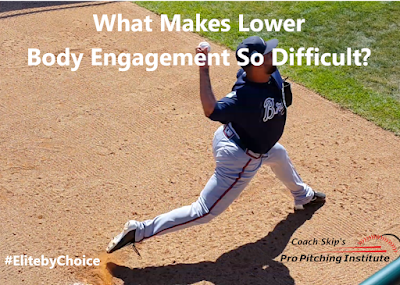Rotation/Forward Momentum Don’t Mix
Rotation is straight-line momentum that moves around a vertical axis.
The issue … You can’t have straight-line momentum and rotation at the same time.
2 Conditions for Lower Body Engagement
First, you must use your foot placements to present your body with a vertical axis.
To create lower body rotation, your footwork into your front leg lift must give your lower body a vertical axis to rotate around.
When your footwork causes an upper-body tilt, you lose your lower body.
Second, lower body engagement requires two conditions.
1. An initial rotation … an upper-body action uses your vertical front leg lift axis to rotate your body down the mound.
2. Tension … Your foot plant stops your rotation, creates tension between your hip and shoulder positions, and naturally whips your throwing arm into release.
Here’s the issue … Because most Pitchers fail to end their front leg lift with a vertical axis, they can’t rotate down the mound, their foot plant malfunctions, and there’s no tension for their lower body to react to.
As a defense mechanism, without ever realizing it’s a natural reaction, Pitchers waste their pitching career “working on” their lower body as if it were an action.
5 Simple Fixes for Lower Body Involvement
A string of precise foot placements, knee positioning, and front leg lift actions will engage your lower body every time all the time.
Struggling to engage your lower body, spend a few minutes with Coach Skip over the phone, tell him how you begin your motion, and he’ll give you three things you can do right now that’ll instantly improve your lower body activity.
Coach Skip Fast
Pro Pitching Institute
“The Secret to Fastball Location©” Author/Coach
+1-856-524-3248
skip@propitchinginstitute.com
http://propitchinginstitute.com
#ElitebyChoice




